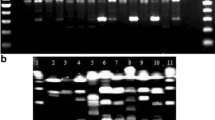Abstract
A new sensitive and specific method for the detection of Erwinia amylovora was developed. The method is based on the detection of a chromosomal DNA sequence specific for this bacterial species and enables detection of E. amylovora pathogenic strains, including recent isolates that lack plasmid pEA29 and thus cannot be detected by the previously popular PCR methods based on the detection of this plasmid. A species-specific random amplified polymorphic DNA (RAPD) marker was identified, cloned, and sequenced, and sequence characterized amplified region (SCAR) primers for specific PCR were developed. The E. amylovora specific sequence, 1269 bp long, was amplified in polymerase chain reaction and detected with electrophoresis in agarose gel stained with ethidium bromide. Amplification with other bacterial species did not produce any PCR product detectable by electrophoresis. Matching of the E. amylovora specific sequence to chromosomal DNA was confirmed by computer analysis of the E. amylovora genome. A consistent sensitivity limit of the method was 3 CFU/reaction, and in some cases it was possible to detect 0.6 CFU/reaction. Due to its high sensitivity and specificity, our method of E. amylovora detection is currently the most reliable, taking into account that the reliability of PCR methods based on plasmid pEA29 has been compromised by the isolation of pathogenic E. amylovora strains that lack this plasmid.
Similar content being viewed by others
References
Miller, T.D. and Schroth, M.N., Monitoring the Epiphytic Population of Erwinia Amylovora on Pear with a Selective Medium, Phytopathology, 1972, vol. 62, pp. 1175–1182.
Ishimaru, C. and Klos, E.J., New Medium for Detecting Erwinia Amylovora and Its Use in Epidemiological Studies, Phytopathology, 1984, vol. 74, pp. 1342–1345.
Roberts, P., Problems Encountered during Immunofluorescence Diagnosis of Fireblight, Plant pathol., 1980, vol. 29, pp. 93–97.
Lin, C.P., Chen, T.A., Wells, J.M., and van der Zwet, T., Identification and Detection of Erwinia Amylovora with Monoclonal Antibodies, Phytopathology, 1987, vol. 77, pp. 376–80.
Llop, P., Bonaterra, A., Penalver, J., and Lopez, M., Development of a Highly Sensitive Nested-PCR Procedure using a Single Closed Tube for Detection of Erwinia amylovora in Asimptomatic Plant Material, Appl. Environ. Microbiol., 2000, vol. 66, pp. 2071–2078.
Llop, P., Donat, V., Rodrigez, M., Cabrefiga, J., Ruz, L., Palomo, J.L., Montesinos, E., and Lopez, M.M., An Indigenous Virulent Strain of Erwinia amylovora Lacking the Ubiquitous Plasmid pEA29, Phytopathology, 2006, vol. 96, pp. 900–907.
Bereswill, S., Bugert, P., Bruchmüller, I., and Geider, K., Identification of the Fire Blight Pathogen, Erwinia amylovora, by PCR Assay with Chromosomal DNA, Appl. Environ. Microbiol., 1995, vol. 61, pp. 2636–2642.
Maes, M., Garbeva, P., and Crepel, C., Identification and Sensitive Endophytic Detection of the Fire Blight Pathogen Erwinia amylovora with 23S Ribosomal DNA Sequences and the Polymerase Chain Reaction, Plant pathol., 1996, vol. 45, pp. 1139–1149.
Guilford, P.J., Taylor, R.K., Clark, R.G., Hale. C.N., and Foster, R.L.S., PCR-Based Techniques for the Detection of Erwinia amylovora, Acta Hortic., 1996, vol. 411, pp. 53–56.
Taylor, R.K., Guilford, P.J., Clark, R.G., Hale, C.N., and Forster, R.L.S., Detection of Erwinia amylovora in Plant Material Using Novel Polymerase Chain Reaction (PCR) Primers, New Zealand J. Crop Horticultural Sci., 2001, vol. 29, pp. 35–43.
Welsh, J. and McClelland, M., Fingerprinting Genomes using PCR with Arbitrary Primers, Nucleic Acids Res., 1990, vol. 18, pp. 7213–7218.
Williams, J. G. K., Kubelik, A.R., Livak, K.J., Rafalski, J.A., and Tingey, S.V., DNA Polymorphisms Amplified by Arbitrary Primers are Useful as Genetic Markers. Nucleic Acids Res., 1990, vol. 18, pp. 6531–6535.
Paran, I. and Michelmore, R.W., Development of Reliable PCR-Based Markers Linked to Downy Mildew Resistance Genes in Lettuce, Theor. Appl. Genet., 1993, vol. 85, pp. 985–993.
Sambrook. J., Fritsch, E.E., and Maniatis, T., Molecular cloning: a laboratory manual, 2nd edition, Cold Spring Harbor: Cold Spring Harbor Laboratory Press, 1989.
Llop, P., Caruso, P., Cuberto, J., Morente, C., and Lopez, M.M., A Simple Extraction Procedure for Efficient Routine Detection of Pathogenic Bacteria in Plant Material by Polymerase Chain Reaction, J. Microbiol. Methods, 1999, vol. 37, pp. 23–31.
Rosello, M., Vidal, S.G., Tarin, A., Llop, P., Goris, M.T., Donat, V., Chartier, R., Paulin, J.P., Gardan, L., Penalver, J., and Lopez, M.M., Characterization of an Erwinia sp. Isolated from Necrotic Pear Blossoms in Valencia, Spain, Acta Hortic., 2002, vol. 590, pp. 139–142.
Salm, H. and Geider, K., Real-time PCR for Detection and Quantification of Erwinia amylovora, the Causal Agent of Fireblight, Plant pathol., 2004, vol. 53, pp. 602–610.
Brown, E.W., Janisiewicz, W., and van der Zwet, T., Preliminary Phenotypic and Genetic Differentiation of the Fire Blight Bacterium Erwinia amylovora, Acta Hortic., 1996, vol. 411, pp. 199–210.
Brennan, J.M., Doohan, F.M., Egan, D., Scanlan, H., and Hayes, D., Characterization and Differentiation of Irish Erwinia amylovora Isolates, J. Phytopathol., 2002, vol. 150, pp. 414–422.
Kreader, C.A., Relief of Amplification Inhibition in PCR with Bovine Serum Albumin or T4 Gene 32 Protein. Appl. Environ, Microbiol., 1996, vol. 62, pp. 1102–1106.
Nagai, M., Yoshida, A., and Sato, N., Additive Effects of Bovine Serum Albumin, Dithiothreitol, and Glycerol on PCR, Biochem. Mol. Biol. Int., 1998, vol. 44, pp. 157–163.
PCR Technology: Principles and Applications for DNA Amplification, Ed. Erlich, H.A. New York: Stockton Press, 1989.
PCR Protocols: A Guide to Methods and Applications, Eds. Innis, M.A., White, T.J., and Sninsky, J.J. San Diego, California: Academic Press, Inc., 1990.
Author information
Authors and Affiliations
Corresponding author
Rights and permissions
About this article
Cite this article
Obradovic, D., Balaz, J. & Kevresan, S. Detection of Erwinia amylovora by novel chromosomal polymerase chain reaction primers. Microbiology 76, 748–756 (2007). https://doi.org/10.1134/S002626170706015X
Received:
Issue Date:
DOI: https://doi.org/10.1134/S002626170706015X




